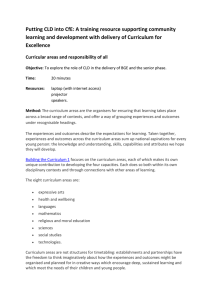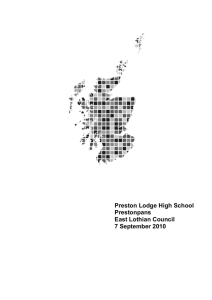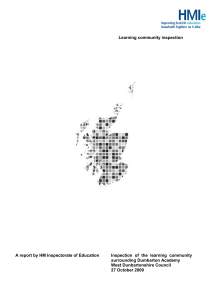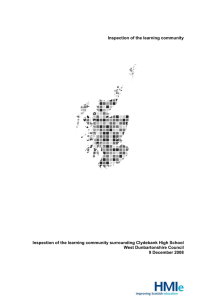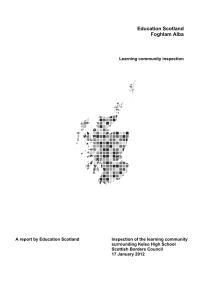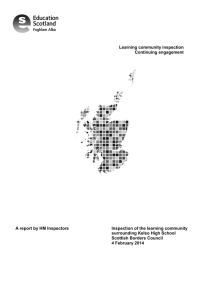Learning community inspection A report by HM Inspectorate of Education
advertisement
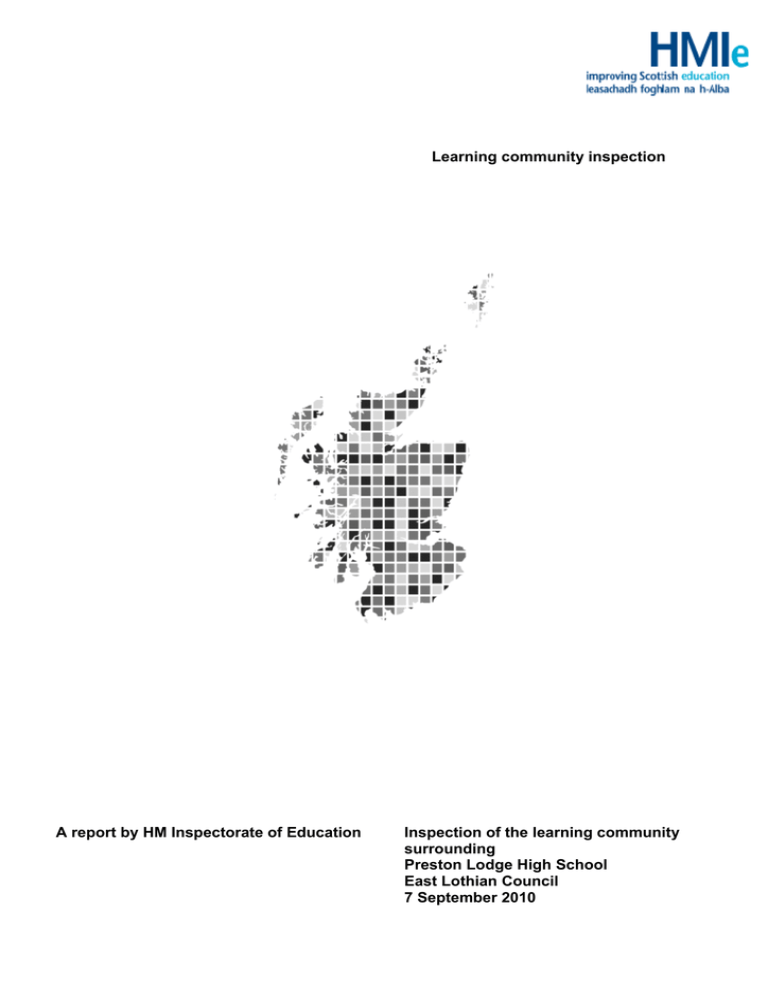
Learning community inspection A report by HM Inspectorate of Education Inspection of the learning community surrounding Preston Lodge High School East Lothian Council 7 September 2010 We inspect learning communities in order to let those who use services and the local community know whether learning communities provide appropriate learning opportunities and help learners in their development. We are also interested in how community and voluntary groups are helped to contribute to making communities better places to live and work. At the end of inspections, we agree ways in which staff and volunteers can improve the quality of learning for young people and adults and how the impact of community and voluntary groups can be further developed. At the beginning of the inspection, we ask managers and staff about the strengths of the learning community, what needs to improve, and how they know. We use the information they give us to help us plan what we are going to look at. During the inspection, we join other activities which young people, adults and community groups are involved in. We also gather the views of learners, active community members and staff. We find their views very helpful and use them together with the other information we have collected to arrive at our view of the quality of provision locally. This report tells you what we found during the inspection and the quality of learning and development provided. We describe how well learners are doing and how good the learning community is at helping them to learn. We comment on how well staff, learners and groups work together and the difference they are making in the learning community. Finally, we focus on how well the learning community is led and how leaders help the learning community achieve its aims. If you would like to learn more about our inspection of the learning community, please visit www.hmie.gov.uk. Contents 1. The learning community 2. Particular strengths of the learning community 3. How well do participants learn and achieve? 4. How well are communities developing and achieving? 5. How effective are providers in improving the quality of services? 6. Does the learning community have a clear sense of direction? 7. What happens next? 1. The learning community The learning community surrounding Preston Lodge High School includes the communities of Port Seton, Prestonpans, Longniddry and Cockenzie. The area is mixed with some fairly affluent communities. According to the Scottish index of Multiple Deprivation, two data zones in Prestonpans are in the 15% most deprived in Scotland. There is a tradition of community activity and involvement and a strong sense of community. Community learning and development Service (CLDS) is the primary deliverer of CLD services although there are a range of active partnerships with other agencies. 2. Particular strengths of the learning community • Highly motivated and committed staff and volunteers. • Very good quality facilities for learning. • Strong and effective capacity building leading to good outcomes. • Very positive use of community arts and music as a vehicle for learning. • Good relationships and rapport between staff and learners. 3. How well do participants learn and achieve? CLD providers are offering a very good range of high quality services for young people, adults and community groups. CLDS and other partners work well with Preston Lodge High School to effectively track and monitor young people unlikely to have a positive destination after leaving school. Several are now gaining jobs or going to college. Increasing numbers of young people are gaining Bronze and Silver Duke of Edinburgh’s awards. ‘YouthVision’, the East Lothian strategy for youth work, is helping to effectively target services by gathering and using information about what young people are involved in. The ‘Hearts Onside’ evaluation report shows that most participants achieved their personal goals and all improved their levels of confidence. Almost all young people using the health drop-in are returning for further visits. CLDS staff are setting targets and reporting regularly on progress in their operational plan. Targets are appropriately linked to the Single Outcome Agreement and national outcomes. However, there would be benefit from working more closely with partners to develop this further. Targets set for English speakers of other languages (ESOL) learners are being met and there is good progress towards adult guidance targets. Many of those seeking help from ‘Guideline’, the adult guidance service are going on to achieve positive outcomes such as employment or further learning. All CLDS staff are using Project Files to plan and record their work effectively. There is scope to extend 1 this to include partners particularly in terms of measuring the impact of capacity building activity. Adult Literacy and Numeracy reports provide good information on progression but do not yet provide comparisons with previous years. Tracking of the contribution of volunteering activity could be improved. Young people Young people are benefiting from a very good range of needs-led, well-planned, and effective programmes. Highly skilled and committed staff are impacting positively on young people’s lives. Almost all young people report that they feel safe, nurtured and respected in their learning programmes. An innovative ‘YouthVision’ for East Lothian is leading to good outcomes. Young people at the Red School Youth Centre are actively shaping the club programme and are encouraged to take on responsibility. They are gaining qualifications and securing employment. At the Pennypit Special Needs Youth Club, young people are developing skills through a range of new challenges. The involvement of a drama instructor is helping them achieve skills in script writing and performing. Most participants are achieving certificates through the Duke of Edinburgh’s Award Scheme. A P7 curricular programme at Prestonpans Primary School is helping young people to better understand and describe their learning. Almost all young people said they had learned how to resolve conflict and work as a team. Youth mentors at the holiday playscheme report that their involvement is giving them a sense of responsibility and improved leadership and communication skills. Their experiences are preparing them for work and contribute to their CV. The ‘Youth Gym’ at Port Seton community centre is effectively engaging young people referred via the Youth Justice system. Participants successfully secured funding for the gym and prevented its closure. Anti-social behaviour has declined as a result. A few girls report improvements in health and fitness. Young people would benefit from the continued development of the ‘YouthVision’ as a means to consult and communicate. A wider range of accredited programmes, for example Youth Achievement Awards and Millennium Volunteering would further enhance young people’s learning. Adults Adult learning programmes provide for a wide range of learners and include targeted provision for those with learning disabilities, vulnerable young parents and those whose first language is not English. Almost all learners have individual learning plans and can talk about wider benefits in their personal and working lives. They report increases in confidence, feelings of being less isolated and a wide range of social and health benefits. High numbers of learners are progressing to accredited Scottish Qualification Authority (SQA) learning programmes, particularly in maths and English. The partnership between CLDS and Jewel and Esk College is enabling learners to achieve accreditation in their local community by using home study materials. They are well supported by CLDS staff. ESOL provision is using innovative and effective evaluation methods to engage with learners. A few learners report that programmes have been life changing. 2 Very good crèche facilities are helping to break down barriers to learning and are enabling parents to attend learning programmes. Mums R Us provides effective learning experiences for young lone parents. Many are progressing to other learning opportunities and employment. All learners have increased their personal aspirations. Programmes for trainees with learning difficulties in the Pitstop Café is helping them to develop skills, knowledge and gain accreditation. Good arrangements have been developed between the Pitstop Café and Starbucks and a few trainees have successfully secured jobs. The majority of learners accessing the Adult Guidance Service (Guideline) are progressing to employment. Whilst there are good relationships between CLDS and a wide range of partners, planning and evaluation of learning programmes needs further development. They could also build stronger links with the library service. Learners may benefit from widening existing SQA accredited programmes to include Core Skill Units. 4. How well are communities developing and achieving? Communities in the Preston Lodge catchment are achieving very well. Almost all groups are active, influential and respond well to local priority needs. Local people are effectively supported by CLD providers to promote learning through the arts. The Three Harbours Festival provides very good learning opportunities. Primary school children, adults and older people are contributing and gaining skills. The Coastal Re-Generation Group is effectively bringing local groups from several small communities together to improve their environment. The Boating and Sailing Club is enhancing skills for adults and young people by providing training at low or no cost. Parents participating in the ‘Patchwork EH32’ group are becoming more active and influential. They report improved confidence and reduced isolation. Active members of the Cockenzie and Port Seton ‘In Bloom’ are improving their local community by growing and creating floral arrangements. Regular newsletters keep the community informed. Members of the committee positively describe major benefits to their mental and physical health. Members of local management committees and groups are very well supported by CLDS staff. Almost all are skilled, confident and active community members. They display a sense of ownership and feel that they have a say in how decisions are made. However, there is potential to create opportunities for sharing of good practice across groups and agencies. Older people at Osborne Court sheltered housing complex are improving their community and making it safer. They campaigned successfully for a pedestrian crossing. The Advisory Committee at Port Seton Centre campaigned successfully for a Community Development Officer to be located in the building. They have also improved the local play park and skateboard facility. 5. How effective are providers in improving the quality of services? CLD providers are planning well for improvement. They use a good range of methods to gather feedback from participants. Twenty five staff and some volunteers successfully completed the ‘Planning For Real’ training and are now 3 using the methods to deliver improvement. This resulted in a successful application to the Fairer Scotland Fund. The Tenants and Residents Association is using the ‘Planning For Real’ methodology to develop their services. The Coastal Regeneration Forum is planning improvements to the local environment and consulting widely. Project files are helping CLD staff to more effectively plan and evaluate their work. This is strengthening how they are working with other agencies including schools. Reporting arrangements are working well and there is a clear focus on outcomes. There is scope for partners to work more closely to deliver on joint outcomes. CLD staff work-plans reflect national priorities. A recent skills audit is helping staff to build capacity. Good practice is being developed and shared. CLD providers are routinely reporting on progress. The ‘Kids on The Water’ report and evaluation identifies benefits to young people and the local community. Participation increased as a result. Objectives set for improving play facilities in Port Seton are being achieved. A clear framework for supporting 16+ developments is in place. Good partnership working is helping providers identify positive outcomes for young people. Community centres are reporting regularly on their activities. However, some annual reports could be more appropriately focussed on outcomes. Regular reporting on progress of ‘YouthVision’ entitled ‘Living The Vision’ is leading to new learning opportunities for young people. A range of methods are being employed to report on progress to stakeholders. These include regular articles in the local press, web sites and information booklets. 6. Does the learning community have a clear sense of direction? The learning community has a clear sense of direction and CLD providers are motivated and committed. There are very strong impacts for young people, adults and the community. Many groups are providing high quality services and there are many examples of community life improving as a result. Strong and developing links with Preston Lodge High School are providing a solid platform for collaborative working that is benefiting young people. A further strengthening of partnerships will provide more and varied learning opportunities. 4 7. What happens next? CLD providers have a good understanding of their strengths and areas for improvement and communities are achieving very well. As a result we have ended the inspection process at this stage. We have agreed the following areas for improvement with the education authority and its partners. • Further extend partnership working to ensure positive outcomes for all learners. • Improve arrangements for tracking learner progress. Quality indicators help CLD providers and inspectors to judge what is good and what needs to be improved in the learning community. You can find these quality indicators in the HMIE publication “How good is our community learning and development? 2”. HMIE checks five important quality indicators to keep track of how well all Scottish CLD provision is doing. Here are the results for the learning community surrounding Preston Lodge High School. Improvements in performance Impact on young people Impact on adults Impact of capacity building on communities Improving services Managing Inspector: Sheila Brown 7 September 2010 5 good very good very good very good very good This report uses the following word scale to make clear judgements made by inspectors. excellent very good good satisfactory weak unsatisfactory outstanding, sector leading major strengths important strengths with some areas for improvement strengths just outweigh weaknesses important weaknesses major weaknesses If you would like to find out more about our inspections or get an electronic copy of this report, please go to www.hmie.gov.uk. Please contact us if you want to know how to get the report in a different format, for example, in a translation, or if you wish to comment about any aspect of our inspections. You can contact us at HMIEenquiries@hmie.gsi.gov.uk or write to us at BMCT, HM Inspectorate of Education, Denholm House, Almondvale Business Park, Almondvale Way, Livingston EH54 6GA. Text phone users can contact us on 01506 600 236. This is a service for deaf users. Please do not use this number for voice calls as the line will not connect you to a member of staff. You can find our complaints procedure on our website www.hmie.gov.uk or alternatively you can contact our Complaints Manager, at the address above or by telephoning 01506 600259. Crown Copyright 2010 HM Inspectorate of Education



